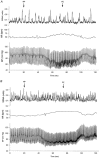Absence of arterial baroreflex modulation of skin sympathetic activity and sweat rate during whole-body heating in humans
- PMID: 11600694
- PMCID: PMC2278882
- DOI: 10.1111/j.1469-7793.2001.0615c.xd
Absence of arterial baroreflex modulation of skin sympathetic activity and sweat rate during whole-body heating in humans
Abstract
1. Prior findings suggest that baroreflexes are capable of modulating skin blood flow, but the effects of baroreceptor loading/unloading on sweating are less clear. Therefore, this project tested the hypothesis that pharmacologically induced alterations in arterial blood pressure in heated humans would lead to baroreflex-mediated changes in both skin sympathetic nerve activity (SSNA) and sweat rate. 2. In seven subjects mean arterial blood pressure was lowered (approximately 8 mmHg) and then raised (approximately 13 mmHg) by bolus injections of sodium nitroprusside and phenylephrine, respectively. Moreover, in a separate protocol, arterial blood pressure was reduced via steady-state administration of sodium nitroprusside. In both normothermia and heat-stress conditions the following responses were monitored: sublingual and mean skin temperatures, heart rate, beat-by-beat blood pressure, skin blood flow (laser-Doppler flowmetry), local sweat rate and SSNA (microneurography from peroneal nerve). 3. Whole-body heating increased skin and sublingual temperatures, heart rate, cutaneous blood flow, sweat rate and SSNA, but did not change arterial blood pressure. Heart rate was significantly elevated (from 74 +/- 3 to 92 +/- 4 beats x min(-1); P < 0.001) during bolus sodium nitroprusside-induced reductions in blood pressure, and significantly reduced (from 92 +/- 4 to 68 +/- 4 beats x min(-1); P < 0.001) during bolus phenylephrine-induced elevations in blood pressure, thereby demonstrating normal baroreflex function in these subjects. 4. Neither SSNA nor sweat rate was altered by rapid (bolus infusion) or sustained (steady-state infusion) changes in blood pressure regardless of the thermal condition. 5. These data suggest that SSNA and sweat rate are not modulated by arterial baroreflexes in normothermic or moderately heated individuals.
Figures



Similar articles
-
Baroreflex modulation of sympathetic nerve activity to muscle in heat-stressed humans.Am J Physiol Regul Integr Comp Physiol. 2002 Jan;282(1):R252-8. doi: 10.1152/ajpregu.00337.2001. Am J Physiol Regul Integr Comp Physiol. 2002. PMID: 11742845
-
Baroreceptor unloading does not limit forearm sweat rate during severe passive heat stress.J Appl Physiol (1985). 2015 Feb 15;118(4):449-54. doi: 10.1152/japplphysiol.00800.2014. Epub 2014 Dec 18. J Appl Physiol (1985). 2015. PMID: 25525210 Free PMC article.
-
Whole body heat stress attenuates baroreflex control of muscle sympathetic nerve activity during postexercise muscle ischemia.J Appl Physiol (1985). 2009 Apr;106(4):1125-31. doi: 10.1152/japplphysiol.00135.2008. Epub 2009 Feb 12. J Appl Physiol (1985). 2009. PMID: 19213933 Free PMC article.
-
Effects of heat stress on baroreflex function in humans.Acta Physiol Scand. 2003 Mar;177(3):321-8. doi: 10.1046/j.1365-201X.2003.01076.x. Acta Physiol Scand. 2003. PMID: 12609002 Review.
-
[Heat stress and human baroreflex function].J UOEH. 2010 Dec 1;32(4):329-40. doi: 10.7888/juoeh.32.329. J UOEH. 2010. PMID: 21229726 Review. Japanese.
Cited by
-
Chronic heart failure does not attenuate the total activity of sympathetic outflow to skin during whole-body heating.Circ Heart Fail. 2013 Mar;6(2):271-8. doi: 10.1161/CIRCHEARTFAILURE.112.000135. Epub 2013 Feb 8. Circ Heart Fail. 2013. PMID: 23395933 Free PMC article.
-
Influence of nonthermal baroreceptor modulation of heat loss responses during uncompensable heat stress.Eur J Appl Physiol. 2010 Feb;108(3):541-8. doi: 10.1007/s00421-009-1255-7. Epub 2009 Oct 28. Eur J Appl Physiol. 2010. PMID: 19862547
-
Heat stress and baroreflex regulation of blood pressure.Med Sci Sports Exerc. 2008 Dec;40(12):2063-70. doi: 10.1249/MSS.0b013e318180bc98. Med Sci Sports Exerc. 2008. PMID: 18981943 Free PMC article. Review.
-
Mechanisms of cutaneous vasodilation during the postmenopausal hot flash.Menopause. 2011 Apr;18(4):359-65. doi: 10.1097/gme.0b013e3181f7a17a. Menopause. 2011. PMID: 21107299 Free PMC article.
-
Blood pressure regulation III: what happens when one system must serve two masters: temperature and pressure regulation?Eur J Appl Physiol. 2014 Mar;114(3):467-79. doi: 10.1007/s00421-013-2652-5. Epub 2013 May 1. Eur J Appl Physiol. 2014. PMID: 23636697 Free PMC article. Review.
References
-
- Bini G, Hagbarth KE, Wallin BG. Cardiac rhythmicity of skin sympathetic activity recorded from peripheral nerves in man. Journal of the Autonomic Nervous System. 1981;4:17–24. - PubMed
-
- Birkett CL, Ray CA, Anderson EA, Rea RF. A signal-averaging technique for the analysis of human muscle sympathetic nerve activity. Journal of Applied Physiology. 1992;73:376–378. - PubMed
-
- Crandall CG, Johnson JM, Kosiba WA, Kellogg DL., Jr Baroreceptor control of the cutaneous active vasodilator system. Journal of Applied Physiology. 1996;81:2192–2198. - PubMed
-
- Crandall CG, Levine BD, Etzel RA. Effect of increasing central venous pressure during passive heating on skin blood flow. Journal of Applied Physiology. 1999;86:605–610. - PubMed
Publication types
MeSH terms
Substances
Grants and funding
LinkOut - more resources
Full Text Sources
Miscellaneous

